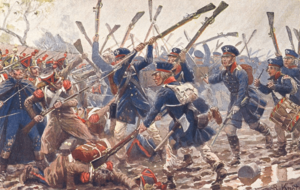Battle of Hagelberg facts for kids
Quick facts for kids Battle of Hagelberg |
|||||||
|---|---|---|---|---|---|---|---|
| Part of the War of the Sixth Coalition | |||||||
 Prussian Landwehr at Hagelberg by Richard Knötel |
|||||||
|
|||||||
| Belligerents | |||||||
| Commanders and leaders | |||||||
| Karl Friedrich von Hirschfeld Alexander Chernyshyov |
Jean-Baptiste Girard (WIA) (POW) | ||||||
| Strength | |||||||
| 11,310 11 guns |
8,900 23 guns |
||||||
| Casualties and losses | |||||||
| 1,759 | 6,000 8 guns |
||||||
The Battle of Hagelberg was a fight that happened on August 27, 1813. It was part of a bigger conflict called the War of the Sixth Coalition. This battle took place after the Battle of Grossbeeren and before the major Battle of Leipzig. In this fight, a group of Prussian soldiers, many of them Landwehr (citizen-soldiers), teamed up with Russian Cossacks. They fought against French, Saxon, and Westphalian forces. The Prussian and Russian side won this important battle.
Contents
Before the Battle
In August 1813, French troops led by Marshal Oudinot wanted to capture Berlin. This would have given them an advantage in peace talks. However, their plan failed on August 23, 1813, at the Battle of Großbeeren.
To help Oudinot's troops, a large group of about 8,900 soldiers marched from the fortress of Magdeburg. These soldiers were mainly French, Saxon, and Westphalian. They were led by General Jean-Baptiste Girard.
Setting Up Camp
Girard's troops did not arrive in time to help in the Berlin attack. So, they set up their camp west of Belzig. They were very careful to protect their camp from the east. This was because they worried about attacks from Russian Cossacks. However, they did not protect the western side of their camp very well.
The Battle Begins
The Prussian general Karl Friedrich von Hirschfeld planned a surprise attack on Girard's camp. He gathered his troops near Görzke. His force included four regular battalions and fourteen Landwehr battalions. He also had twelve squadrons of Landwehr cavalry. These troops had been in western Brandenburg.
Prussian Forces Gather
By the evening of August 26, General Hirschfeld had gathered a strong force. He had 10,350 infantry soldiers and 960 cavalry soldiers. He also had 11 cannons. The next morning, a local forester helped guide Hirschfeld's soldiers. They marched through the forest towards Hagelberg.
Around 2 p.m., the Prussian troops reached the edge of the forest. They were now to the west of Girard's camp. They quickly got into position and attacked.
Fighting in the Rain
The battle was tough for the new Landwehr soldiers. They were not very experienced. But brave officers, like Lieutenant Colonel Friedrich August von der Marwitz, kept their units organized.
It had been raining since noon, making the fight even harder. The gunpowder and rifles often got wet. This meant soldiers mostly fought with bayonets and the butts of their rifles. After 5 p.m., heavy rain made it almost impossible to fire guns. A very bloody hand-to-hand fight broke out near a garden wall in northern Hagelberg.
Cossacks Turn the Tide
Russian Cossacks, led by General Alexander Chernyshyov, were staying in nearby Belzig. They joined the battle and helped the Prussians win. Some Saxon soldiers who were fighting for the French side then switched to the Prussian side.
After 6 p.m., General Girard's troops began to retreat towards Magdeburg. General Girard himself was seriously wounded. The Prussians were very tired, so they did not chase the French very hard.
The Cossacks took over the chase. They attacked the French in Wiesenburg that night. They captured a cannon and took many prisoners.
Aftermath
The Prussians lost 1,759 soldiers who were either killed or wounded. Only about 3,000 French soldiers made it back to Magdeburg safely. General Girard's army was almost completely destroyed. Only 1,700 men returned to Magdeburg.
This battle, though smaller than some, was very important. It was one of the first times the newly formed Landwehr fought. It showed that these citizen-soldiers were valuable. After the battle, many soldiers received awards. A total of 136 Iron Crosses were given out. These went to 80 officers, 30 non-commissioned officers, and 26 regular soldiers.


